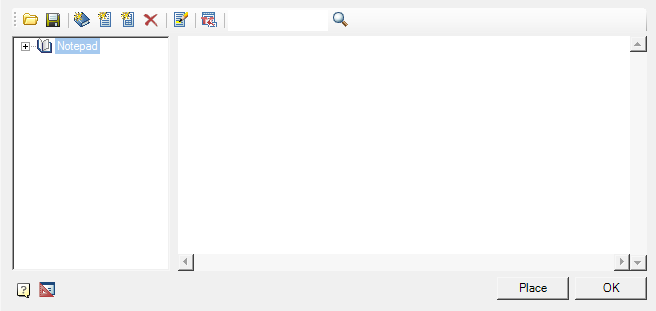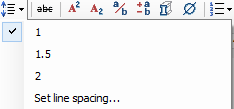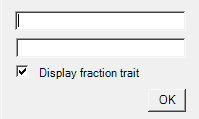-
-
-
-
-
-
-
-
-
-
-
-
-
-
-
-
-
-
-
-
-
-
-
-
-
-
-
-
-
-
-
-
-
-
-
-
-
-
-
-
-
-
-
-
-
-
-
-
-
-
-
-
-
-
-
-
-
Technical conditions
-
-
-
-
-
-
-
-
-
-
-
-
Technical conditions
 Main menu: Mechanical - Drawing title/ Borders >
Main menu: Mechanical - Drawing title/ Borders > Technical conditions.
Technical conditions.
 Ribbon: Mechanical - Title blocks >
Ribbon: Mechanical - Title blocks > Technical conditions.
Technical conditions.
 Toolbar: "Drawing title/ Borders" >
Toolbar: "Drawing title/ Borders" >  Technical conditions.
Technical conditions.
 Command line: MCTT.
Command line: MCTT.
A distinctive feature of nanoCAD Mechanica is the possibility of linking the designation of textual information on the drawing with the text in the technical requirements.
When writing paragraphs of technical requirements (hereinafter TC), you can make reference within the proposal of the paragraph of technical requirements to any position or affixed view.
The textual information is the tolerances and dimensions, drawing zones, designations of types, cuts, sections, marking signs, marking of welded joints, position.
A change in the value of the textual information (for example, a part position number) will result in an automatic change in the TC text. If this position has been deleted, a warning will appear about the need to check a particular item of requirements.
The relationship between the TC and the designation works in the opposite direction. Changing the order of the points of the requirements (their numbering) is automatically reflected in the designation on the drawing (for example, a marking mark, the designation of which contains the item number from the technical requirements).
Editor

Main menu
- File
- Clear - clear TC.
- Open file - the command opens the TC from a previously saved file.
- Save file - command saves TC to * .rtf file.
- Close without save - the command closes the TC editing dialog box without saving.
- Edit
- Undo - command cancels last action.
- Redo - the command repeats the previously canceled action.
- Insert title - command inserts a title in front of TC items.
- Delete title - command removes TC title.
Toolbar
-
 Open file - the command opens the TC from a previously saved file.
Open file - the command opens the TC from a previously saved file. -
 Save file - command saves TC to * .rtf file.
Save file - command saves TC to * .rtf file.Important! The special characters used in the editor are lost when they are transferred to an external file. -
 Fill in MSWord - the command opens a new document in MSWord and inserts the text TC.
Fill in MSWord - the command opens a new document in MSWord and inserts the text TC.Important! The special characters used in the editor are lost when they are transferred to an external file. -
 Notebook - command opens interface notebook.
Notebook - command opens interface notebook.
-
 Undo - command cancels last action.
Undo - command cancels last action. -
 Redo - the command repeats the previously canceled action.
Redo - the command repeats the previously canceled action. -
 Add paragraph (CTRL+ENTER) - command adds a new TC item.
Add paragraph (CTRL+ENTER) - command adds a new TC item. -
 Delete paragraph (CTRL+DEL) - command deletes TC item.
Delete paragraph (CTRL+DEL) - command deletes TC item. -
 Replace paragraph up - the command moves the TC item at which the cursor is located, higher up in the list.
Replace paragraph up - the command moves the TC item at which the cursor is located, higher up in the list. -
 Replace paragraph down - the command moves the TC item at which the cursor is located, down the list.
Replace paragraph down - the command moves the TC item at which the cursor is located, down the list. -
 Decrease Indent - the command reduces the indent of selected items.
Decrease Indent - the command reduces the indent of selected items.

-
 Increase indent - command increases the indent of selected items.
Increase indent - command increases the indent of selected items.

-
 Line Spacing - the command opens the list for setting the line spacing. Adjust line spacing of selected items.
Line Spacing - the command opens the list for setting the line spacing. Adjust line spacing of selected items. 
- 1 - set 1 leading (unit for measuring line spacing). Line spacing is added after the TC item.
- 1.5 - set 1.5 leading. Line spacing is added after the TC item.
- 2 - set 2 leading. Line spacing is added after the TC item.
- Set line spacing... - the command allows you to specify your own line spacing. Line spacing is added after the TC item.
-
 Superscript - translates the selected text into superscript.
Superscript - translates the selected text into superscript.
-
 Subscript - translates the selected portion of the text into a subscript.
Subscript - translates the selected portion of the text into a subscript. -
 Insert fraction - the command calls the "Fraction" dialog box in which the numerator and denominator are specified. The fraction is inserted into the text TC.
Insert fraction - the command calls the "Fraction" dialog box in which the numerator and denominator are specified. The fraction is inserted into the text TC.
-
 Insert tolerance - provides the ability to insert a tolerance. When called, the "Tolerances" dialog box opens.
Insert tolerance - provides the ability to insert a tolerance. When called, the "Tolerances" dialog box opens. -
 Insert material - provides the ability to insert material. When called, opens the "Material" dialog.
Insert material - provides the ability to insert material. When called, opens the "Material" dialog.
-
 Insert spec symbol - allows you to insert special characters in the text TC.
Insert spec symbol - allows you to insert special characters in the text TC. -
 Numeration - the command allows you to select the design option for TC items.
Numeration - the command allows you to select the design option for TC items.
Note: To create a hierarchical list it is necessary to press the "Tab" key on an empty item. A new child level has been created. To return to the previous level, press the "Enter" key on an empty item.
-
 Insert position - the command associates text fragments in the TC with a graphical representation of the positions in the drawing.
Insert position - the command associates text fragments in the TC with a graphical representation of the positions in the drawing.To insert a link in the TC editor, place the cursor on the insertion point of the associated symbol and click on the "Insert position" button, select a position in the drawing.
Related information is displayed in blue in the TC editor. When you click on a link, the application will display the associated graphical representation.
-
 Insert view/cuts - the command associates text fragments in TC with a graphical representation of views, sections and sections in the drawing.
Insert view/cuts - the command associates text fragments in TC with a graphical representation of views, sections and sections in the drawing.To insert a link in the TC editor, place the cursor on the insertion point of the associated symbol and click on the "Insert view / cuts" button, select the view, section or section.
Related information is displayed in blue in the TC editor. When you click on a link, the application will display the associated graphical representation.
-
Ruler. The ruler is used to position the lines relative to the entire TC document. Sliders are used to position the lines.

1. The bottom slider adjusts the indentation of all paragraph lines except the first line.
2. The top slider adjusts the indent of the first paragraph line.
3. The angle slider adjusts the text indent from the numbered list marker.
Context menu
The context menu uses standard commands for text fields.
Setting text options
To set the TC text parameters (font height and slope, indent from the title block, etc.) open the dialog box "Settings".


 De
De  Es
Es  Fr
Fr  Pt
Pt 
